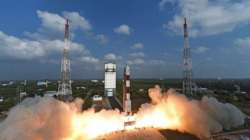Chandrayaan-2, India's second mission to moon, set for July 15 launch | Details
Chandrayaan-2, India's second mission to the moon, will be launched on July 15. ISRO chairperson Dr K Sivan announced on Wednesday that Chandrayaan-2 will carry 13 scientific sattelites with it and weighs about 3.8 tonnes, the equivalent of eight elephants.

Chandrayaan-2, India's second mission to the moon, will be launched on July 15. ISRO chairperson Dr K Sivan announced on Wednesday that Chandrayaan-2 will carry 13 scientific satellites with it and weighs about 3.8 tonnes, the equivalent of eight elephants. Chandrayaan-2 is an advanced version of the previous Chandrayaan-1 mission, which was launched about 10 years ago. Chandrayaan-1 had 11 payloads -- five from India, three from Europe, two from the US and one from Bulgaria -- and the mission had the credit for discovery of water on the lunar surface.The 1.4-tonne spacecraft was launched using PSLV and the orbiter had orbited 100 km from the lunar surface.
Chandrayaan-2: Launch date
India's second mission to the moon, Chandrayaan-2, is set to be launched on July 15. The landing on the moon near the South Pole, an uncharted territory so far, would be on September 6 or 7.
Chandrayaan-2: Launch time
Chandrayaan-2 launch will take place at 2.51 am onboard the GSLV MK-III vehicle from the spaceport of Sriharikota in Andhra Pradesh.
Chandrayaan-2 launch: Spacecraft weight, modules, payloads
The spacecraft, with a mass of 3.8 tonne, has three modules -- Orbiter, Lander (Vikram) and Rover (Pragyan).
Orbiter will have eight payloads, Lander three and Rover two.
Chandrayaan-2 launch: Mission cost
The mission cost of Chandrayaan-2 with regard to the satellite was Rs 603 crore. The cost of FSLV MK III is Rs 375 crore.
Here's what will happen when Chandrayaan-2 launches:
Orbiter, with scientific payloads, would orbit around the moon. Lander would soft land on the moon at a predetermined site and deploy Rover. The scientific payloads on board Orbiter, Lander and Rover are expected to perform mineralogical and elemental studies of the lunar surface.
The Orbiter and Lander modules would be interfaced mechanically and stacked together as an integrated module and accommodated inside the GSLV MK-III launch vehicle. Rover is housed inside Lander.
After the launch into an earth-bound orbit by GSLV MK-III, the integrated module would reach the moon orbit using the orbiter propulsion module and subsequently, Lander would separate from Orbiter and soft land at the predetermined site, close to lunar South Pole. Rover would roll out for carrying out scientific experiments on the lunar surface, noting that instruments were also mounted on Lander and Orbiter for carrying out scientific experiments.
ALSO READ | Chandrayaan-2, India's second moon mission set for July launch: All you need to know